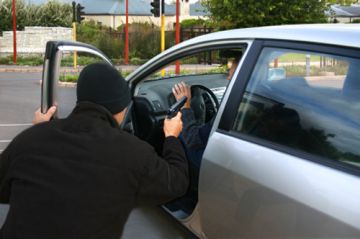
Most motorists don’t heed advice about known hazards until they happen to them or someone they know. If you write about safety issues long enough, you’ve interviewed a lot of people with first hand experience. And few things stay with you longer than those first-person tales.
Consider the horror that befell Kids and Cars founder Janette Fennell and her family in 1995. She and her husband were carjacked, robbed and left in their trunk in an remote location. They escaped, but didn’t know the fate of their infant son until they arrived back home to find him sitting in his baby seat unharmed in the driveway.
She went on to found the advocacy group Kids and Cars and successfully lobbied to get trunk releases required in all new vehicles.
Sound farfetched? So might some of the other things on this list, but you’ll be well prepared if you heed this tips in the unlikely — but not impossible — chance they happen to you.
Carjacker in or around your car
Keeping an eye on your surroundings is key to staying safe, say Charley and Tracy Vega, co-founders of Simple Defense for Women, a program that teaches personal safety to women. People tend to come and go in parking lots, so if someone is standing around for a long time, they might be looking for a potential victim, says Charley.
• Get in your car quickly and lock the doors. One foot out the door while moving things around gives them time, Even if cars lock automatically after a few miles, that’s not fast enough.
• What if someone is after you or in your car? Give them what they want and get as far away as possible.
• If the car is not moving, get out even if it’s in drive. If it is moving, stop fairly quickly and get out. You don’t want to drive anywhere with that person in the vehicle.
• If someone reaches around you from the back seat – or behind you anywhere – and covers your mouth, Tracy recommends taking one finger and peeling it back abruptly. It will likely break their finger and give you the time needed to get out of the car.
♦ Flat tire in a tunnel or anywhere at night
The biggest mistake people make is to get out of their cars around traffic when something goes wrong, says Vernon Betkey, a former Maryland state police officer who headed highway safety for Maryland for several years. When one of his daughters called after getting a flat in the Harbor Tunnel near Baltimore, Betkey says he assured her cars would begin to slow and stop around her – and that she was to remain in her car.
Even seemingly desolate stretches of highway are regularly patrolled so even if you don’t have a working mobile phone, help shouldn’t take too long. If a purportedly helpful stranger approaches, says Betkey, don’t open the door. Just talk to them through the window and ask them to call the police if you are unable to do so.
♦ Car off a bridge (or otherwise sinking in water)
The National Highway Traffic Safety Administration says an average of 384 occupants die in motor vehicle crashes that involve submersion in water each year. And that doesn’t include those that happen during floods.
• Aside from the sheer fright of what might happen, one of the biggest problems is the water will cause the power to go out and almost everything in cars these days is electrical. It’s almost impossible to open the door until the car’s filled with water too, and that may be too late.
• The minute or so that it takes for a car to land in water and become submerged is the period when it’s easiest to escape and survive, according to researchers from the University of Manitoba. They recommend exiting through the side windows while the vehicle is still floating. So think and act fast; don’t even try to call for help.
•A Life Hammer device is handy in this situation. It’s a small tool that can punch out windows and cut the seat belt if that’s needed for you to get out of the car in a crash or submersion. It includes a razor blade-type feature to cut the belts.
The Life Hammer could come in handy in case of a carjacking or creepy guy in the tunnel. The Vega’s and Betkey both recommend also getting pepper spray to keep on your key chain. It’s important to keep the pepper spray in your hand – not deep in your purse – when you might need it. Especially at night at in such places as a gas stations or dark parking lots. Most people, says Charley, wait until something happens to them to buy it. Don’t make that mistake.




